

GORT-4 Instructional Video. Assessment: In Practice. Learn what you are measuring with each literacy skill assessment, the age or grade when a skill should be mastered, and when during the school year you should administer the assessments.
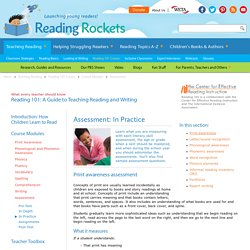
You'll also find sample assessment questions. Print awareness assessment Concepts of print are usually learned incidentally as children are exposed to books and story readings at home and at school. Concepts of print include an understanding that print carries meaning and that books contain letters, words, sentences, and spaces. It also includes an understanding of what books are used for and that books have parts such as a front cover, back cover, and spine. Students gradually learn more sophisticated ideas such as understanding that we begin reading on the left, read across the page to the last word on the right, and then we go to the next line and begin reading on the left. How to Support Students With Dysgraphia. The thought ended almost before it started: “This is so overwhelming.”
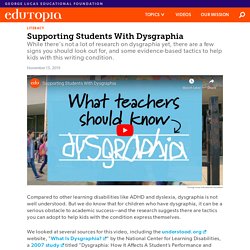
It was all one teacher managed to type before she stopped short, vexed into silence, perhaps, by the sheer size of the problem. In the pregnant pause that followed, undoubtedly, every teacher tracking the unspooling thread—about the dizzying, rapidly escalating viral crisis that was closing schools across the country—recognized the chasm they were all facing as well, and scrambled to fill in the blank. In the next few hours, over 500 teachers joined two Facebook conversations about teaching during the coronavirus pandemic, spilling out their concerns and anxieties: What will we do if the schools close for months?
What is Aphasia? Aphasia Definitions - National Aphasia Association. Aphasia is an impairment of language, affecting the production or comprehension of speech and the ability to read or write.
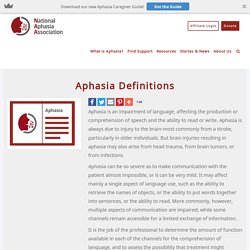
Aphasia is always due to injury to the brain-most commonly from a stroke, particularly in older individuals. But brain injuries resulting in aphasia may also arise from head trauma, from brain tumors, or from infections. Aphasia can be so severe as to make communication with the patient almost impossible, or it can be very mild. It may affect mainly a single aspect of language use, such as the ability to retrieve the names of objects, or the ability to put words together into sentences, or the ability to read. More commonly, however, multiple aspects of communication are impaired, while some channels remain accessible for a limited exchange of information. Wisconsin Legislature: PI 11.36(6) PI 11.36 NoteNote: Appendix A specifies the recommended regression formula for calculating significant discrepancy scores.
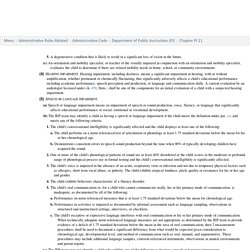
This appendix does not apply three years after December 1, 2010. /code/admin_code/pi/11 true administrativecode /code/admin_code/pi/11/36/6 Department of Public Instruction (PI) administrativecode/PI 11.36(6) administrativecode/PI 11.36(6) section true. WIAT-III Wechsler Individual Achievement Test 3rd Ed. Woodcock-Johnson III Diagnostic Reading Battery (WJ III DRB) Author(s): Richard Woodcock, Nancy Mather, and Frederick A.
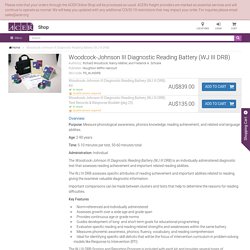
Schrank Overview Purpose: Measure phonological awareness, phonics knowledge, reading achievement, and related oral language abilities. Age: 2-90 years Time: 5-10 minutes per test, 50-60 minutes total Administration: Individual The Woodcock-Johnson III Diagnostic Reading Battery (WJ III DRB) is an individually administered diagnostic test that assesses reading achievement and important related reading abilities. The WJ III DRB assesses specific attributes of reading achievement and important abilities related to reading, giving the examiner valuable diagnostic information. Important comparisons can be made between clusters and tests that help to determine the reasons for reading difficulties.
Key Features The WJ III DRB Scoring and Reporting Program is included with each kit and provides several types of interpretative reports: Summary Report — Communicates test results to teachers and other professionals. Already registered, please login. Toolkit - Main Page. Structured Literacy: Best Practices for Evidence-Based Literacy Instruction. Today, we know a lot more than we did decades ago about how children learn to read.
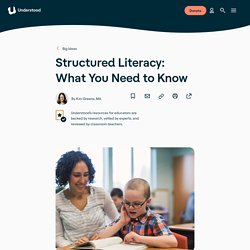
Thanks to research on the science of reading, we can use evidence-based literacy instruction for all students. The International Dyslexia Association uses the term structured literacy to describe this type of teaching. What Is Structured Literacy? It’s important to know both what to teach (the content) and how to teach it (the delivery) with structured literacy. Phonology: the study of sounds in spoken wordsSound-symbol (orthography): how to map sounds (phonemes) to letters (graphemes)Syllables: knowing the types of syllables and how to divide words into syllablesMorphology: the study of base words and affixes (prefixes and suffixes)Syntax: understanding the grammatical order of words (like sentence structure)Semantics: understanding the meaning of words and sentences.
What Is Dyslexia. Dyslexia is a learning disability in reading.

People with dyslexia have trouble reading at a good pace and without mistakes. They may also have a hard time with reading comprehension, spelling, and writing. But these challenges aren’t a problem with intelligence. Dyslexia is a common condition that makes it hard to read. Some experts believe that between 5 and 10 percent of people have it. Kids with dyslexia don’t outgrow it. People with dyslexia typically have trouble reading fluently.
Dyslexia can create difficulty with other skills, too. DeterminingAppropriateAssessmentAccommodations article from NCLD(2) Sld faq.